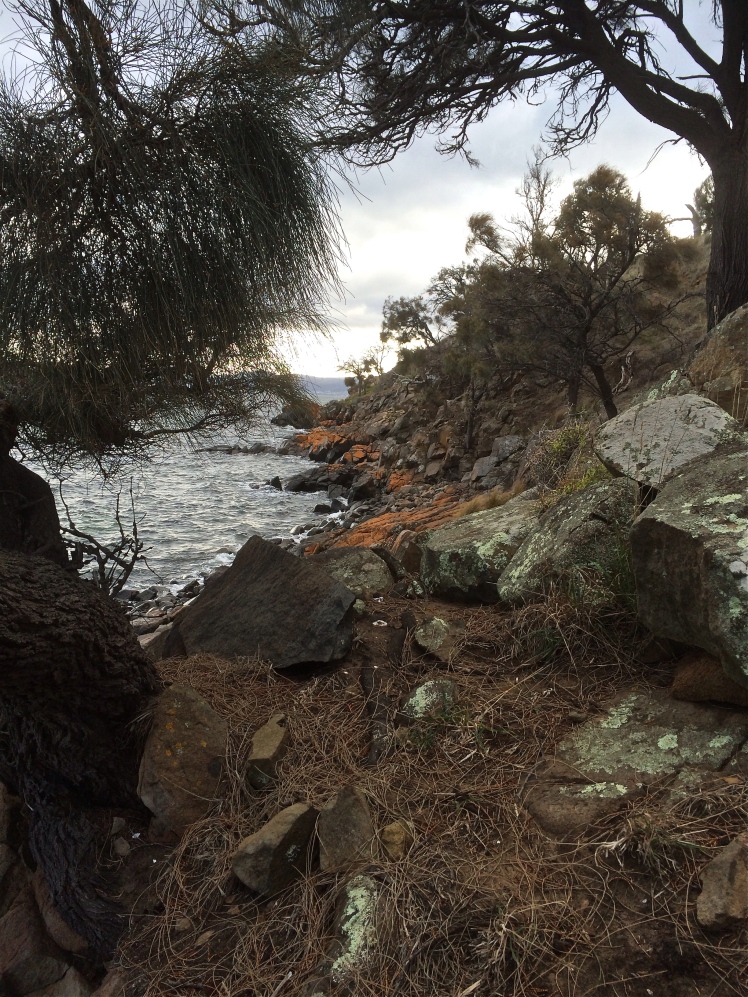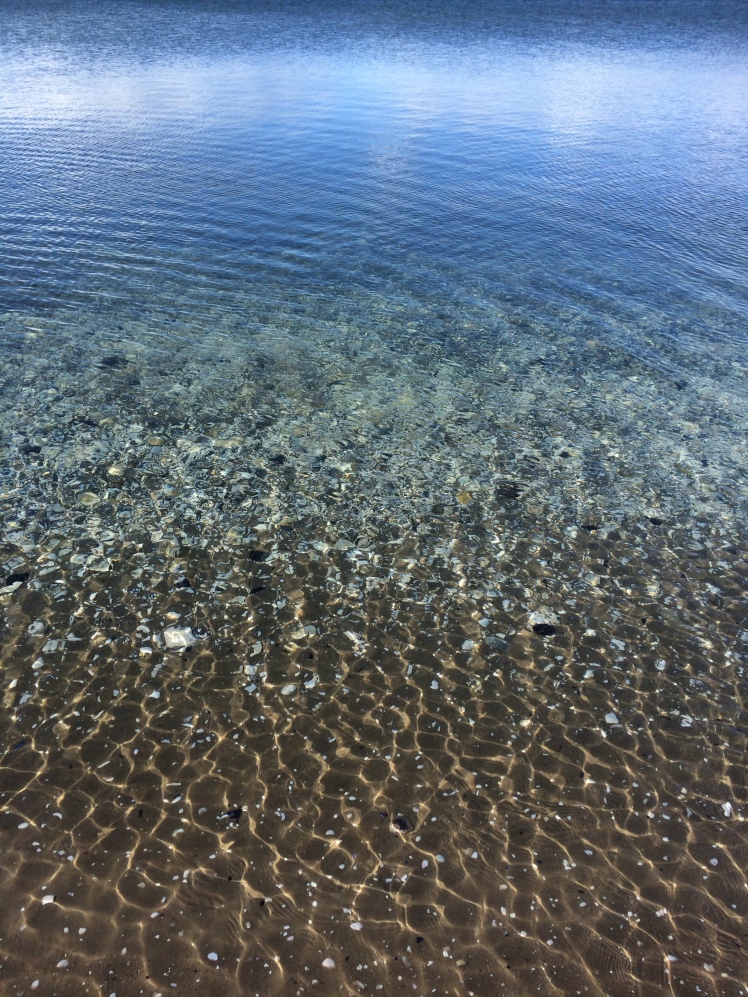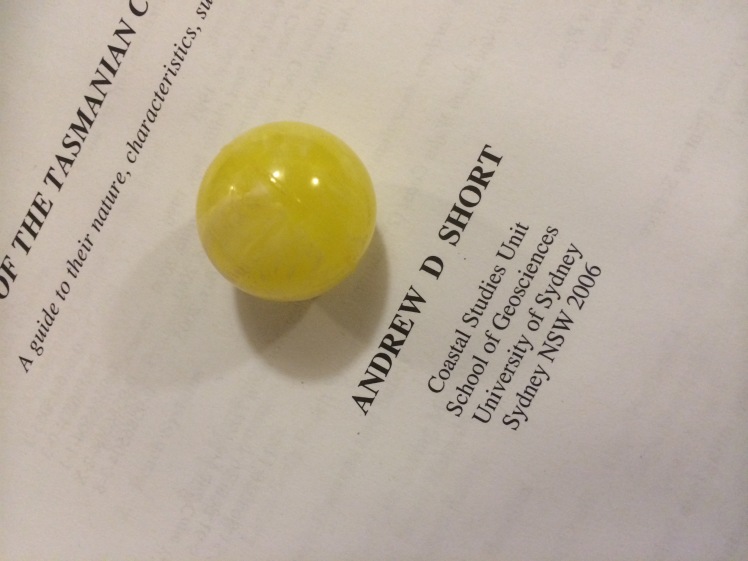Derwent River: South Arm Beaches: Opossum and Half Moon Bays

Clarence Beaches: The South Arm Peninsula
Lauderdale, an outer suburb about a forty minute drive east from central Hobart, is situated on the isthmus where the South Arm peninsula officially begins. Carry on through it and there are two routes you can take to reach the Arm End beaches that are on the far side of a second more southerly isthmus. Of the two options, I like taking Rifle Range Road. It wanders along the western slope of Mount Augustus and continues onto Collins Springs Hill. There are tracts of dry sclerophyll forest, views west across Ralphs Bay to kunanyi, views east over Calverts Beach and lagoon and finally a spectacular view of the Iron Pot and Betsy Island.
.

Opossum Bay Beaches
Opossum Bay stretches its 1.5 km length west to southwest. It harbours three beaches, although, if you’re not a local, its easy to make the mistake of thinking that there is one beach only. Opossum Bay beach is easy to find while the other two are easy to overlook, unless you are paying close attention to the landscape.
I pretty much started this blog here, with my first walk around Gellibrand Point, accessible from this point. Now I was back here with my friend Cathy. We’d set ourselves the goal of walking the coastline to the end of Seven Mile Beach and we’d planned to do it on low tide days over the coming months.
T 422 Mitchells Beach: in the shadow of its middle sibling

The tide was out on Mitchells Beach and it seemed lighter and more gracious than when I had been here last. On that day a band of cobbles barely separated the winter sea from the eroding slope at the western end of Opossum Bay and the stone percussion in the roll of the swell had been audible to us some distance above it. But the day Cathy and I had chosen had begun with a big frost. Now the sky was blue and on the far side of the river there was snow on kunanyi.
We turned our backs to the mountain and walked east along the pale terrace of sand the low tide had exposed, in the long gone footsteps of family bands of the Moomairemener, believed to be members of the Paredarerme (Oyster Bay tribe). They called the land along the eastern shore of the Derwent River Nannyelebata and they were people of both the coast, the river and the lagoons that are to be found on this diverse peninsula, a peninsula largely in kunanyi’s rain shadow with few hills. As there are no real makers of rivers around here (save Den Hill, Jim’s Hill and Blatherwick Rise – all rather too lowly to whip up a creek) their water sources were springs and the freshwater that collected in the dunes, as well as their freedom to follow the seasons further up the river and to cross it in places.
Mitchells is a reflective beach of about 850m, the longest in this bay, and stormy weather can invigorate the waves that are eating away at the weed infested slope. We stopped for a moment because I wanted to try to understand what the stratigraphy was saying about this beach’s past.
Still catching up on each other’s news, we reached the rocky platform and headland that separate this beach from Opossum Bay Beach, embraced with so much enthusiasm by the locals that houses literally perch on the wrack line.
T 421 Opossum Bay Beach: houses as rampart

We walked along sharing the memories it has given us. Cathy knows it far better than me and she mentioned that we had the option of a footpath between here and South Arm. I’ve viewed its houses, boatsheds and slender sweep of sand on windy days from heeling yachts and also when, becalmed, there’s been ample time to absorb the view more fully. The beach houses and shacks on their bluff are the rampart the rising river meets and the views are of the estuary widening.
There’s a difference between walking and exploring, and concluding that today at least we fitted in the latter category, we shunned the pathways on the headland above us at the eastern end in favour of the shoreline and clambered around the headland with its jetty by way of the rocks.

T 420 Glenvar Beach: The Secret Beach
We crossed a boat ramp and walked into the more hidden part of the bay. Too often I’ve been that sort of beach walker who stops at the end of a stroll along the sand without testing its boundaries. That’s why I’d never found Glenvar Beach. Recently a friend had told me that she’d rented a beach house at a Gellibrand Beach. She described where it was and spoke about the lovely way the swells sometimes swept into the bay from three different directions.

Glenvar is definitely the smallest and most crescent shaped beach in the bay. Here, the houses also show an inclination to cosy up to the water, but held more tightly between two headlands, the feeling is more intimate. I figured this had to be my friend’s ‘Gellibrand Beach’. Cathy and I lingered on the rocks before beginning our walk out of it, admiring all the things large and minuscule about it – the nautical things like boat sheds, the sea walls in places, the features in the siltstone – fossils included – a feather or two along with shells and the vibrant seaweeds of the reef.

I came back here the other day after a storm. Kelp lay washed up on the beach. This time I walked the lanes between the houses on on the headland seeking out a path to the beach. That’s the way to arrive on Glenvar. Not by directions but by following the lean of the land until you arrive on the sand.

Pigeon Holes
Blatherwick Rise* stops Glenvar Beach. We set off along the rock platform at its base. The siltstone here has been sculpted by the winds and rain so that its stippled with hollows. I was pretty thrilled to have reached this spot because once, crewing on the big blue Beneteau in a long distance race, a buoy was placed off here and we’d had to check the chart, none of us precisely certain about where the mysterious Pigeons Holes were to be found.
It’s a favourite spot with the cormorants, perhaps because there’s quite a variety of fish here. I counted twenty one of the birds taking in the long view and apart from a gull or two, they were the only members of the avian nations that we saw on this walk. We also discovered the remnants of a battered metal boat lodged on the rocks.



Our rock hopping had warmed us. We took off our jackets and explored the platform with its mollusc rich rock pools fringed with red and green seaweeds. Beneath the water where the rocks give way to sand the stingrays and the flathead lie camaflaged and all these are reasons why divers like this spot.
We walked the shoreline, sometimes scrambling, wondering where above us the house owned by Brian Ritchie (Violent Femmes) happened to be. According to the website for the tv series Sandcastles that featured it, he left the Big Apple seeking the serenity of The Apple Isle and bought this land from Peter Garrett (Midnight Oil and ex Labor MP).
At one point we found a narrow path beneath casuarinas and sauntering along this cliff top path we heard voices below us. The water seemed unusually blue just there. Two heavily tattoed men on a motorboat, oblivious to our presence, were getting ready to dive. We regarded them silently before continuing on, coming to a small beach neither of us expected to encounter. Its beauty was marred by the litter it was assiduously collecting. (Later I checked Short’s inventory but it isn’t noted there.)
We filled our bags with plastic bottles and styrofoam and then clambered over more rocks and down on to another beach in the next bay along.
Half Moon Bay
Like Opossum Bay, Half Moon Bay has three beaches within its 3 km extent and it also faces west across the Derwent’s estuary, which is vast here, the swells and waves from Storm Bay flow directly into the river, merging with the water from the D’Entrecasteaux on the other shore. Humans may demarcate the boundary with a mark (the Iron Pot in this case) but the moon and the weather determine where and how the waters mingle.

T 419 Half Moon Bay Beach and its smaller sibling
This beach (T419) we found ourselves on was known to Cathy but not to me. Robertson (2008) calls it Half Moon Beach and Short (2006) calls it Pigeon Holes Beach . It’s about 150m long and on a summer’s day it would be a lovely place to come to with a beach umbrella and a good book. But if you were a bird, that’s what you’d be dreading. Your eye would be on making a nest here and beach umbrellas play havoc with that.
The smaller beach we’d stopped to spring clean is in effect a little companion tucked into the long headland that is Blatherwick Rise, so seemed to me to be not quite Opossum Bay and not quite Half Moon either. Unrecognised, it’s without a Beachsafe number (unless my beach interpretation is shaky here and I’m suffering from beach confusion).


The view from Half Moon Beach: straight down the D’Entrecasteaux on the other side.
T 418 South Arm Beach
A quick clamber over the next lot of rocks and we were on South Arm Beach, the long, generous curve of sand backed by dunes. We increased our pace because we were fast running out of time. Sometimes we walked below houses. We exchanged waves with a couple on a sundeck toasting their mountain view with glasses of wine. I found an enigmatic layer of shell in the dunes. It could have been a midden, but one of Ralphs Bay’s most intriguing features are the dense layers of shell. This lovely embayment lies held in the crook of the peninsula’s skinny arm and I thought I might be seeing an exposed part of that layer.
We walked passed boat sheds. We passed the conifers. We reached South Arm (no more than a village or a far-flung Hobart suburb, take your pick) and as we turned to walk over the headland by way of the roads, we eyed out the rocks below Johns Point. We’d hoped to walk around and complete Half Moon Bay but we had run out of time.
If we’d taken the South Arm to Opossum Bay trail that runs close to the road, we’d have done that 4.5 km walk in less than two hours, but we had chosen to scramble over rocks instead and we had dallied on beaches. The school bell chimes at 3 p.m. though, and one of us could not be late. That last Half Moon beach would have to wait until next time.

* According to Place Names Tasmania, this name was ‘advised by Mr G. Calvert and Mrs B. Gellibrand; family by this name lived for many years in old days at top of rise on South Arm Road.’ Locals also call it Blatherwick Hill.
** They also record this information about (The) Pigeon Holes: “Pigeons as we know, favour ledges for nesting and roosting. Mr Cramp recalls that pigeons used to nest on a cliff face at Opossum Bay, South Arm. There was a considerable number of them, and the ledges were—“.
Walked on 24 August 2015


























